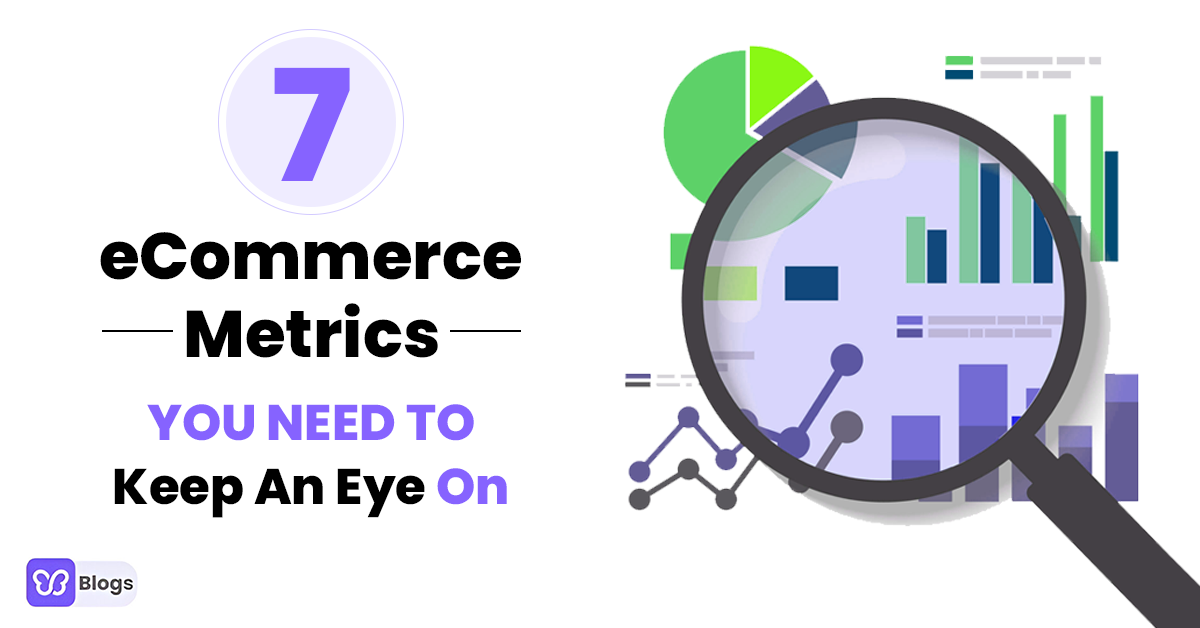What’s the best way to keep improving your eCommerce business?
A. Watch your competitors 👀
B. Study customer behavior 🤔
C. Track your metrics 💡
D. All of the above
The answer is D, but here’s the key: in 2025, your metrics are the backbone of every decision.
Competitor strategies and customer insights matter, but without tracking results, you cannot tell what is working. Metrics are the health check of your business. They reveal which campaigns are driving growth, where customers are dropping off, and which areas need improvement.
With AI-driven personalization, social commerce, and new privacy rules reshaping eCommerce in 2025, relying on guesswork is no longer an option. The brands that win are the ones that measure the right numbers and adapt quickly.
Yes, tracking can feel overwhelming. But when you focus on the most
You need to finish this blog because we'll talk about:
- What are eCommerce metrics?
- Why do you need to track them?
- What are the seven important metrics you should track?
But first...
What Are eCommerce Metrics?
eCommerce metrics are numbers you track to measure how your website or campaigns are performing.
They help you see what is working and guide you in creating better business strategies.
There is no single set of metrics for every business. The right ones depend on your goals and the type of business you run.
But remember, eCommerce metrics are an essential part of your business.
Let me tell you why...
Why Do You Need To Track Your eCommerce Metrics?

Before measuring your eCommerce metrics, you need to understand why you're doing so in the first place.
And there are different reasons why you should track your eCommerce metrics.
Here are three of them...
1. See If You Are Reaching Your KPIs
How would you know if you're succeeding if you don't know what the basis for success is?
Key Performance Indicators are what you'll measure for achieving your goals.
For example, your KPIs are:
- Reach $10,000 in sales
- Drive 5,000 visitors to your website
- Generate 100 new leads
You need to check your eCommerce metrics to know if you're achieving these results.
You can check these insights on your in-platform Statistics page or Google Analytics. It depends on what eCommerce platform you're selling.
Now, if you aren't achieving your KPIs, you need to...
2. Optimize Your Strategies
You can see if the results aren't good by tracking the metrics.
And if they're not, you can improve them.
If you see that you didn't reach your conversion goals, maybe you need to adjust your conversion optimization strategies.
Or, if you didn't bring in thousands of visitors in a month, you may need to optimize your website.
Seeing what worked and didn't work will help you decide which area you should improve on your next campaigns.
Because optimizing your strategies will be your vehicle to...
3. Achieve Your eCommerce Goals
Your eCommerce metrics will be the engine behind that vehicle. It tells you what needs improvement to achieve your goals.
And for eCommerce business owners like you, reaching them is a must because you need to keep your eCommerce store running.
You may have employees, tools, or any business expenses to pay.
So, yep. You need to measure your eCommerce metrics to help you succeed.
And if you're wondering what eCommerce metrics you need, keep an eye on these...
7 eCommerce Metrics You Need To Track
There are a lot of eCommerce metrics you can track. But it depends on your business and what you're trying to achieve.
Here are some of the most important eCommerce metrics you should keep an eye on...
1. Sales Conversion Rate
If your primary goal is to convert many visitors into customers and make more profit, then you need to track your eCommerce conversion metric.
Before we dive into details, how to compute your conversion rate?
First, you need to take your conversions and divide them by the total interactions or visitors on your website.
Make sure that you're taking numbers in the same period. Is it weekly? Monthly?
Let's say within 7 days, you had 1,000 interactions on your eCommerce website. In that period, you were able to have 50 conversions from those interactions.
So, 500 ÷ 10,000 = 5%. That's your eCommerce conversion rate.
But how would you know if that's a good one?
It is said that a good conversion rate is about 10%. So, if you noticed that your metric is less than that, you might need to switch things up.
But if your conversion rate is above that... that doesn't mean you'll stop there.
You have to keep improving your conversion rate.
If you got a 15% conversion rate in July, see what strategies worked and aim for a higher one in the next month.
In computing your conversions, you also need to track your...
2. Customer Acquisition Cost
Converting a customer is a process.
They have to go from not being aware of your brand to purchasing from your eCommerce store. It's not easy and cheap for some eCommerce businesses.
So, computing your CAC or Customer Acquisition Cost will help you determine how much it costs to acquire your customers.
You must divide your marketing cost by your acquired customers to compute this.
.jpg)
What are these marketing costs?
Some examples are tools, ad budget, or your marketing staff. Add everything up before dividing them by the customers you acquired.
For example, your marketing cost is $1000 for July. But you acquired 10 customers in the same month.
Your CAC is $100 per customer.
The point of calculating your CAC is to allocate and plan your budget correctly. You might be overspending on something that doesn't help you convert customers.
For example, you noticed that you have a high CAC and want to reduce it.
It's time to revisit your investments and see which ones bring the most results. From there, you can adjust your marketing budget and compute your CAC next month to see if it works.
And here's another eCommerce metric you need to keep an eye on...
3. Customer Lifetime Value
Customer Lifetime Value or CLV is how much a customer is valued during your relationship with them.
Here's how to calculate it:
%20(1).png)
You need to multiply the average value of sales, the number of transactions, and the retention period.
Why is this a vital eCommerce metric?
CLV is important because it measures your long-term sales. It helps you focus on customers willing to spend money on your eCommerce store repeatedly.
And having a great CLV means that your customers love your products.
This is your chance to think of ways and strategies to maximize these customers and increase your CLV even more.
Speaking of customers who love your products...
4. Customer Retention Rate
Did you know that customer retention is cheaper than customer acquisition?
Yep. That's why you need to ensure that your retention rate is good.
You can find how many customers are repeatedly purchasing on your eCommerce store through Shopify's dashboard or Google Analytics.
Here's how it works on Shopify.
- Go to Shopify Admin.
- Select Analytics, then go to Reports.
- Go to the Customers section and choose the report you want to see.
For Shopify analytics, there are two categories you can check: Loyal customers and Returning customers.
You can see their details... such as their name, email address, date of their first and recent order, the total number of orders, average order value, and the total amount they spent on your online store.
If you don't have a good number of loyal and returning customers, take it as a sign to optimize your marketing strategies.
There are different ways to increase customer loyalty, such as loyalty programs and strong customer service.
Another metric you need to track is...
5. Average Order Value
What is AOV or Average Order Value?
AOV is the average amount your customers spend on your online store.
This is how to calculate it:
.jpg)
This is one of the most important eCommerce metrics because knowing your AOV will help you develop your marketing and business strategies.
If you're unhappy with your AOV, you can optimize your eCommerce site to increase it!
You can also try other marketing strategies, like creating product bundles or upselling.
And that's not all...
6. Churn Rate
Since you need to learn about every aspect of your business, the eCommerce churn rate is also one of the important metrics.
If you're not that familiar with Churn Rate, let me explain.
Churn rate is the percentage of customers that left your eCommerce brand over a period of time.
It depends on your business model because churn can mean different things for every business.
If you're a subscription-based business, churns are unsubscribers. It can also be customers who are deactivating their purchase accounts. Or unsubscribers to your email marketing campaigns.
This is how to calculate your churn rate:

Let's say you lost 10 subscribers or customers in July. And before losing them, you had 50 customers.
10 lost customers divided by 50 customers at the beginning of July = 20% churn rate.
But what's the average churn rate?
For SaaS companies that target small business owners, it's 3-5% monthly. And for consumer goods, it's about 9.62% annually.
If you have a high churn rate, you might need to rethink your strategies to increase customer satisfaction and the number of repeat customers.
And last but not least important eCommerce metrics...
7. Social Media Engagement
Social media engagement is also one of the key eCommerce metrics you need to check.
Why? Because social media marketing is a part of your marketing strategy. It helps you drive website traffic, increase conversions, and build an online presence.
How to check your social media engagement?
Luckily, social media platforms have their Analytics or Insights page for you to check how your pages and content are performing.
Remember... to measure eCommerce success, it's also essential to look at your marketing channels.
Because in the eCommerce industry, they are one of your conversion drivers.
Make sure to check them out once in a while!
Keep An Eye Out For These eCommerce Metrics!
Stability is important for your eCommerce store.
And in your case, you must constantly develop new ways to strengthen your brand's stability.
You always have to track these metrics and find ways to improve your strategies.
But one of the excellent ways to improve it is by having a functional eCommerce theme!
You can't increase your sales if your website contains unnecessary features.
You need a theme with features that matter and is user-friendly.
Debutify is not just an eCommerce theme. It's also a Profit Optimization Partner. With over 50 Add-Ons, increasing your metrics is possible.
Try Debutify For Free And Improve Your Metrics!
14-Day Trial. 1-Click Install. No Credit Card Required.





